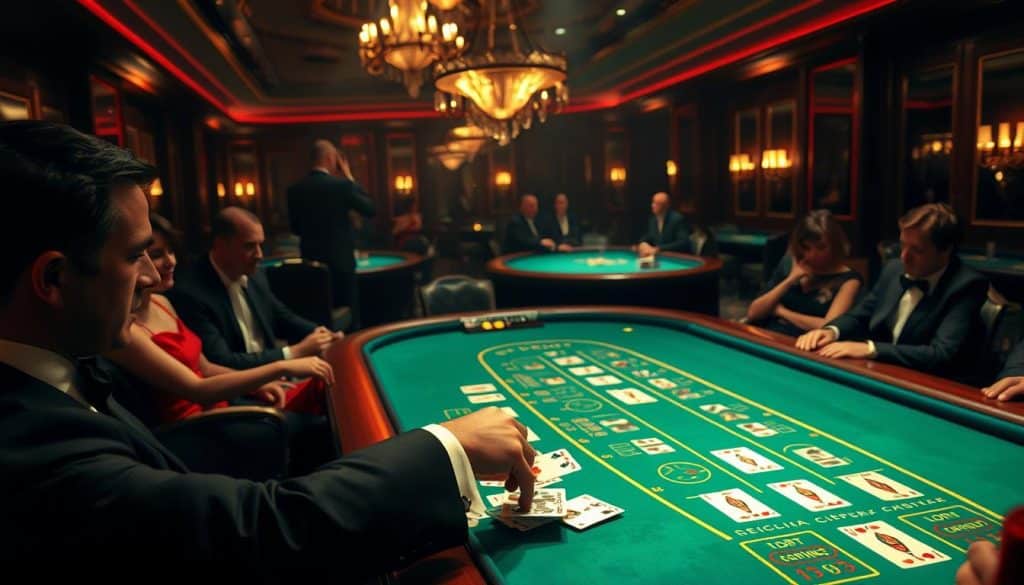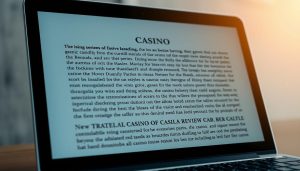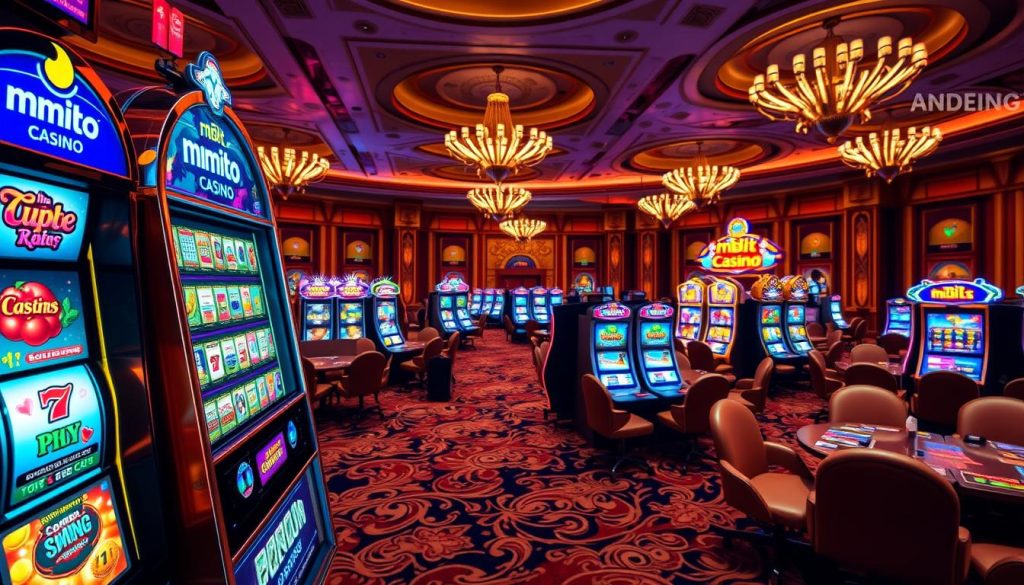Did you know? Nearly 30% of players in New Zealand who try casino games online start with baccarat. That’s a lot for a game often seen as only for big spenders. This surprising fact is why I felt compelled to write a beginner’s guide to baccarat. It’s all about giving practical advice to get you started.
As someone who’s played a lot and reviewed games, I’ve explored sites like Sweeptastic. I’ve looked into how they work, from how they return what you put in, to how you bet, and even how you get prizes. These sites offer games where you use virtual coins. And when you collect enough, you can exchange them for real money. I’m going to share what I’ve learned to help you play baccarat, both live and online.
This piece isn’t just a guide. It’s a route to understanding baccarat with clear steps and rules, beginner tips, and handy tools. I’ll walk you through how to play, reveal useful info from my own tests, and suggest the best platforms and apps. Plus, there’s a special FAQ section for players from New Zealand. This guide is all about real insights, no nonsense.
Key Takeaways
- This beginner’s guide to baccarat is practical and experience-driven, aimed at New Zealand and online players.
- Social casino platforms like Sweeptastic use Lucky Coins and Sweeps Coins; Sweeps Coins redeem at 1 SC = $1 after 100 SC.
- Games on these platforms are RNG-driven and often supplied by named providers such as Betsoft and BGaming.
- You’ll get baccarat gameplay steps, basic strategies, and tools to practice online safely.
- Later sections will include statistics and platform recommendations based on hands-on testing and reported RTP data.
Introduction to Baccarat: What You Need to Know
The first time I played baccarat in Auckland, it seemed elegant and a bit mysterious. After learning a few basic rules, I realized its mystery was more about appearance than actual complexity. This intro is for anyone who wants to know baccarat basics and get some practical tips from my own experiences.
Brief history of baccarat
Baccarat started in Europe during the 19th century, blending Italian and French card game traditions. It evolved in private gatherings before becoming a standard casino game. Nowadays, Punto Banco is the preferred style in commercial settings, with strict rules, suitable for online play through platforms like Betsoft and BGaming.
Popular variations of baccarat
Punto Banco is quite popular, especially on websites and apps in New Zealand. Players bet on the Player, Banker, or a Tie. The dealer follows specific steps. Chemin de Fer and Baccarat Banque offer more player decisions but are less common online. Mini-Baccarat is fast-paced and has lower bets, good for casual play.
Why choose baccarat?
Baccarat is appealing because it’s quick to learn and play speeds along. The Banker bet has one of the lowest house advantages, which is good for careful players. Baccarat suits those who like to spot patterns and manage their emotions, without needing complicated strategies.
From what I’ve seen, baccarat combines luck with a bit of skill. A good guide will show you the fundamentals first, then offer tips on betting strategies and limit setting. This balance makes the game enjoyable without risking too much money.
Understanding the Baccarat Table and Rules
I first played baccarat in Auckland and then online. The table might seem easy, but mastering the layout and the rules is key. I’ll explain the seating, card math, and betting options to help you play confidently.
The table and player spots have a set pattern. Casinos like SkyCity have marked areas for Banker, Player, and Tie bets. Mini-baccarat has a smaller set-up. Online games use similar markings and show virtual bets and chips clearly.
In Punto Banco, it’s less about positions. The dealer handles the cards following baccarat steps. Before a hand starts, players bet on Banker, Player, or Tie.
The game’s rules are straight to the point. Each side, Player and Banker, gets two cards. Remember, only the last digit of the total counts. So, 13 is really 3, but 7 stays as 7.
Card values are easy to remember: Aces are worth 1, 2 through 9 keep their face value, and 10s and face cards are 0. An 8 or 9 right away means a natural win, ending that round.
When there’s no natural, set rules determine if a third card is drawn. This happens without any player input. These rules smooth out the game and keep it moving.
Betting options can affect your game’s outcome. A Player bet gives a 1:1 payout without commission. Banker bets also pay 1:1 but take a 5% commission. Tie bets can pay more, like 8:1, but they’re riskier.
Side bets depend on the place and the provider. Casinos may have pair or big/small bets, and online games might have special side bets. Check the return to player (RTP) and commissions because they change from site to site.
From my experience, games vary in rules. Sweepstakes games use Sweeps Coins, which can turn into cash. Lucky Coins are just for playing. Some sites are open about slot RTPs, but card game RTPs can be harder to find.
Here’s a simple guide to key baccarat aspects and the usual rules.
| Element | What It Means | Impact on Play |
|---|---|---|
| Table Areas | Banker, Player, Tie bet boxes; virtual seats online | Where you place chips; defines betting options |
| Card Values | A=1, 2–9 face value, 10/J/Q/K=0 | Totals use last digit; key to resolving hands |
| Natural | Total of 8 or 9 on first two cards | Round ends immediately; highest priority |
| Drawing Rules | Fixed tables decide third card for Player/Banker | Removes player choice; speeds baccarat gameplay steps |
| Banker Bet | Pays ~1:1 minus commission (commonly 5%) | Statistically best bet after commission |
| Player Bet | Pays 1:1 with no commission | Simple and clear for new players |
| Tie Bet | Higher payout (e.g., 8:1) with worse odds | High variance; avoid for steady play |
| Side Bets | Pair bets, big/small, proprietary online options | Higher house edge; fun for casual stakes |
How to Play Baccarat: Step-by-Step Guide
I’ll guide you through the basics so you can enter a game confidently. This guide talks about getting ready to play, making your first bet, and understanding how cards are scored. It’s useful whether you’re playing in a real casino or online.
Preparing to Play: What You Need
To play in a real casino, you’ll need photo ID and a clear plan for your money. You should also know the table’s minimum bets. It’s smart to check these limits before playing.
For online play, you must set up a verified account and choose a currency. A stable internet connection is also important. Use platforms like Sweeptastic and follow their steps for setting up. Remember, verification is required for redeeming prizes.
Making Your First Bet
Pick a bet size that matches the table’s limits. Bet on the Player, Banker, or a Tie before the deal. For live games, place chips on the bet area. Online, click the area, set your bet, and hit “Deal.”
Tip: Begin with small bets on the Banker to understand the game better. Small bets help you learn the rules without risking too much.
Understanding the Card Values
Card values are straightforward. Aces are worth 1 point. Cards 2 through 9 are at face value. Tens and face cards are 0. To find a hand’s value, add the card values and ignore the first digit.
In Punto Banco, the third-card draw has clear rules. The player doesn’t decide on the draw; it happens automatically. Knowing these rules helps, even though you don’t control the draw.
Online platforms like BetMGM and LeoVegas offer fair baccarat games. These games follow strict rules for drawing and dealing. You often see RTP information, adding transparency to your online play.
Baccarat Strategies for Beginners
I’ve spent many hours at live tables and in online lobbies. I was testing simple strategies that help focus the play. A good baccarat strategy includes setting clear limits, having a session plan, and knowing how stake choices can affect your risk. In this article, I share practical tips used to stay disciplined and enjoy baccarat more.
Betting systems add structure but don’t change the game’s odds. Take the Martingale approach: you double your bet after a loss, aiming to recover it with a win. While it seems smart, it’s actually quite risky. You’ll need a lot of money and might hit table limits before recovering losses. Systems can help manage emotions, but they’re not a guaranteed way to make money.
Some players find lower-volatility methods more suitable. The Paroli system encourages pressing winners, not chasing losses. Fibonacci increases bets more gradually, using a mathematical sequence to reduce swings in your bankroll. Sticking with the same stake, or flat-betting, minimizes variance. Each method affects bankroll swings differently. Choose one fitting your risk tolerance and session objectives.
The house edge is always working against players. On average, Banker bets give the house about a 1.06% edge, after the standard 5% commission. Player bets are slightly worse off, with a 1.24% edge. Tie bets are the riskiest, with house edges sometimes exceeding 14%. Understanding these statistics helps you place bets more wisely.
Casinos differ in their commission rules. Most land-based and online venues charge 5% on Banker wins. However, payout structures can vary on social and sweepstakes sites. It’s crucial to understand these rules before betting real money, as they influence your playing style and strategy choices.
Many players like to keep track of game outcomes using scoreboards like Big Road. I do this too, not to outsmart the game but because it helps manage my bets. Every deal is independent from the last, meaning streaks are just by chance. Viewing patterns as a psychological aid, not a prediction tool, is beneficial.
I make it a point to follow my own set of betting rules. If I hit a loss limit or reach my session goal, I walk away. This prevents me from chasing losses or falling into the trap of thinking I’m due for a win. Remember, staying disciplined is key in baccarat, even more so than having a clever betting strategy.
Here’s a simple guide to help you choose a betting system. It will help align with your bankroll size, your willingness to take risks, and your goals for the session.
| System | Risk Level | Bankroll Needed | Best Use |
|---|---|---|---|
| Martingale | High | Large — can escalate fast | Short runs where limits allow recovery |
| Paroli (positive progression) | Medium | Moderate — manages wins | When you want to ride streaks, limit downside |
| Fibonacci | Medium-Low | Moderate — slower growth | Players preferring methodical loss recovery |
| Flat-betting | Low | Small to moderate | Preserve bankroll, reduce variance |
| Pattern-guided bets | Variable | Depends on chosen stake | Psychological discipline and bet sizing |
Baccarat Graphs and Statistics
I track both live and online baccarat outcomes. A quick glance at the graphs and statistics tells me a lot. I note down streaks, shoe changes, and how long a session lasts. This helps me manage risk better.
I use charts to track player vs. banker win rates. Over time, these rates get close to what you’d expect. The banker wins a bit more often, and ties are pretty rare. Generally, banker wins 45–46% of the time, players win about 44–45%, and ties happen 9–10% of the time.
Player vs. Banker: Win Rates
I look at how often players win compared to the banker. There are always small differences. But they become less noticeable over thousands of hands. For example, divide Rp100,000 into ten parts for sessions. Each session shows how swings can affect your money.
Trends in Baccarat Betting
Online and mini-baccarat have made the game more popular. More people are playing on their phones, which is great for quick practice. Also, social casinos add baccarat to attract players. Here’s a study on winning consistently: demonstration of persistent strategies.
Statistical Analysis of Baccarat Outcomes
I do basic checks like looking at the expected value of bets. For instance, a $1 bet on the banker usually loses about $0.0106. Since the game can be unpredictable, planning how much money you use is key. I often use graphs that show wins and losses over time, how long winning or losing streaks last, and how often each bet wins.
I rely on fair gaming practices from certified platforms for accurate reporting. Combining visual aids with stats gives you a clear picture. It helps you understand your chances, see patterns, and avoid relying on luck alone.
Tools to Enhance Your Baccarat Game
I’ve found tools that make learning baccarat easier and faster. They help turn strategies into actions. This makes every practice count. Here are my top picks for players everywhere.
Online calculators baccarat are crucial for setting up my game plan. They help me understand risks and rewards before playing. I also model different strategies to see potential outcomes.
Even small tools can make a huge impact. For example, a tracker app helps me see how my strategies work over time. It also lets me compare my expectations with real results. This stopped me from making costly mistakes.
Baccarat apps are great for learning without losing money. I like apps that save my game history. It helps me spot patterns and understand the game’s true nature.
Platforms with social-sweepstakes let you practice with virtual coins. They mimic real game environments. But use them to get the feel of the game, not to build your strategy.
Always try platforms on a mobile browser first. Add a shortcut to your screen and use secure logins like Face ID if you can. Look for sites with clear return-to-player (RTP) info and secure payouts. Joining Players’ Clubs can be rewarding too.
Here are some essential tools to start with:
- EV calculator or expected-value spreadsheet for planning.
- Bankroll-sizing tool for managing your money.
- Betting-sequence tracker for different betting strategies.
- Apps that offer practice games and save your history.
- User-friendly platforms with clear RTP info and good support.
To streamline your practice, combine a baccarat guide with a bankroll spreadsheet. Then, practice for an hour daily using baccarat apps. It’s a smart way to improve without wasting money.
Predictions and Trends in Baccarat
I keep a close eye on the baccarat scene and notice significant trends for New Zealand players. Changes like mobile-first tables, sweepstakes-style platforms, and clearer payout displays are shaping game choices. These trends are shaping my predictions about baccarat and its impact on player habits here.
I study New Zealand’s gambling trends through research and playing games myself. Online and social casinos are becoming more popular quickly. Kiwis prefer trusted global sites for their convenience and safety. At the same time, there’s a push for better ID checks and safer gambling tools. This influences where people choose to spend their money.
Experts predict that games which are simple and quick will remain popular. Mini-baccarat and games that don’t take long to play are getting more attention. Sites that clearly show game payouts and return-to-player (RTP) percentages gain players’ trust. This information helps shape my near-term predictions for baccarat.
Loyalty programs are becoming key tools for keeping players. Some have as many as 20 levels and keep players coming back. Expect to see more personalized offers and rewards tied to special events. These strategies will likely affect player loyalty and frequency of play.
Technology plays a big role in baccarat in three areas: ensuring fair play, improving mobile experiences, and integrating live dealers. Companies like Betsoft and BGaming are setting new standards. Better interfaces result in smoother play and longer gaming sessions.
Blockchain and provably fair technologies are starting to emerge. They offer more transparency but are still quite rare in baccarat. Expect to see some experiments and cautious use rather than big changes soon. This slow pace will influence tech’s role in baccarat in the coming years.
To make sense of these trends, I’ve created a summary of key factors and what they might lead to.
| Driver | Current Impact | Near-Term Prediction |
|---|---|---|
| Mobile-first design | High: most new sessions start on phones | Growth: more mini-tables and quick rounds |
| Sweepstakes & social formats | Moderate: useful where cash play is limited | Expansion: hybrid models combining SC/LC with clear rules |
| Loyalty programs | Rising: multi-level rewards increase retention | Intensify: targeted promos and tiered benefits |
| Provider quality (Betsoft, BGaming, GameArt) | High: drives player trust and UX expectations | Continued focus: certified RNGs and polished UIs |
| Blockchain / provably fair | Low: experimental trials underway | Selective adoption: transparency pilots in niche markets |
Looking at New Zealand’s gambling trends, there’s a clear move towards user-friendly platforms. This, combined with better technology and rules, sets the stage for reliable baccarat predictions. I’m keeping an eye on partnerships between providers and changes in user experience to spot important trends.
Frequently Asked Questions About Baccarat
I keep a short FAQ for quick questions I hear a lot in casinos and online. These answers are based on real experience with live and online games. They are straightforward and helpful.
What is the minimum bet amount?
The minimum varies by table and operator. Mini-baccarat at places like SkyCity often has lower limits than the bigger rooms. Online platforms may have different minimums, using Lucky Coins or Sweeps Coins.
A tip: Always check the minimum bet required. For online games, small bets may start at about $4.99 in Lucky Coins. Bigger tables might ask for $25 or more per bet.
How does the commission on banker bets work?
Winning Banker bets usually have a 5% commission. This is because this bet has a slight edge. So, if you win $100, you get $95 back plus your initial bet.
Commission can also be a flat fee sometimes. It’s important to read the rules and terms, especially online. This is because the rules for converting Sweeps Coins might change your payout.
Can you play Baccarat online in New Zealand?
Yes, players from New Zealand can play at many international online casinos. Sites like Sweeptastic welcome international players with sweepstakes mechanics for play and prizes.
To cash out, you’ll need to verify your identity. The number of Sweeps Coins you need and the time it takes can vary. Always check if the platform is legal and fits your age before you play or pay.
Conclusion: Your Baccarat Journey Starts Here
I’ve shown you how to start playing baccarat, from understanding the table to making bets. It boils down to three main bets: Player, Banker, and Tie, with set rules in Punto Banco. The Banker bet is often your best bet, despite the commission. Avoid Tie bets due to the high house edge. Practice with demo games to learn without losing money.
Some tips: start with small bets and favor the Banker for a better chance. Don’t rush into Tie bets. Before using real money, try betting strategies in a demo or on a spreadsheet. If you’re aiming to use Sweeps Coins, get your ID and address proof ready early to avoid payout delays. Playing on mobile is usually easier, so bookmark the site and use two-factor authentication.
Sweeptastic, for instance, offers games that are fair, loyalty rewards, and clear rules on turning Sweeps Coins into cash. If you’re curious about live dealer games, check out recent industry launches here. Keeping track of your baccarat games and outcomes can really help. A thoughtful plan can turn your practice into successful gaming with real money.
Think of this article as your starting point in learning baccarat. Know the rules, practice often, and be smart with your money. Also, don’t forget to verify your account early if you want to redeem Sweeps Coins. This mix of advice and clear rules will guide you, especially when playing online in New Zealand.










